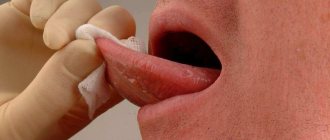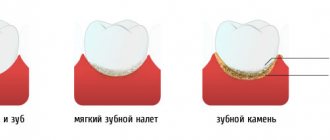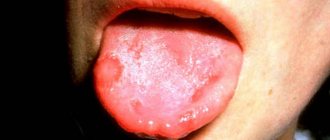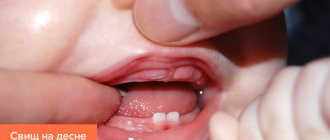What is
A lump is a formation of varying size, formed from the upper layers of the mucous membrane. The neoplasm may be white or red, as well as a bluish tint. Inside the cavity there is content consisting of lymph, blood clots, pus or pathologically altered cells.
There may be several reasons for the formation of a tumor. Most often this is damage to the mucous membrane or the development of other diseases. That is why it is important to promptly establish the cause of its occurrence, before the pathological process spreads to other tissues of the oral cavity.
Treatment is carried out after diagnostic testing and exclusion of malignancy, since a lump in the sublingual area may appear as a result of the development of oncology.
Patient reviews
“All my life I suffered from speech disorders, I even went to a speech therapist, but I didn’t achieve much effect. Besides, I have a slightly incorrect bite. I didn’t understand what the problem was, but in the end, at a dentist’s appointment, a shortening of the frenulum was discovered. It was quickly trimmed and after a few days I noticed how much easier it became to talk and even eat. Thank you very much to the doctors of the clinic!” Vladislav, 28 years old
“After the birth of the child, I almost immediately realized that he could not moisten milk normally. I was very scared, you never know what kind of disease could manifest itself. But a small frenulum was quickly discovered and plastic surgery was performed. And now there are no problems. Thank you very much!" Alina, 25 years old
“Thank you to the doctors for the quick and painless operation. I am always afraid of any interventions, but here they did it very carefully, without discomfort. Very pleased with the service and results.” Svetlana, 40 years old
Conclusion: Trimming a shortened frenulum of the tongue is a fairly simple operation that does not take much time. It is necessary at any age to restore normal functionality of the oral cavity. Sign up for a consultation at the Smile clinic in Ivanovo for a comprehensive examination and pain-free manipulation.
Classification
Cysts, lipomas, papillomas, and lymphangiomas usually form under the tongue. The most common types of formations that form on the oral mucosa include:
- Sialadenitis.
- Salivary gland cyst.
- Lipoma.
- Papilloma.
- Hemangioma.
- Lymphangioma.
Each type of neoplasm is characterized by certain symptoms that appear as the lump grows. They also have different causes.
Sialadenitis
Appears against the background of inflammation of the salivary glands. The causes are usually viruses, infections and pathogenic microorganisms. They penetrate into the oral cavity not only with food, but also from inside the body.
In medicine, the disease is called salivary stone disease, in which a white lump forms. A stone formed in the cavity of the formation clogs the duct and causes stagnation.
Symptoms of the disease include:
- Painful sensations in the area of the salivary glands.
- Decreased salivation and constant dry mouth.
- Difficulty swallowing.
- Enlarged gland.
You may also feel pressure and tension in the area of the duct. Treatment for salivary stone disease occurs surgically.
Cyst
A cyst under the tongue is rare. The disease is characterized by the formation of a tumor in the maxillofacial area. The cavity of the neoplasm is filled with secretion. There are several types of cysts:
- Dermoid. This is a small cone of white or gray color. At the initial stage, there are no symptoms other than mild discomfort. Over time, difficulty swallowing and chewing food appears. This type is a congenital disease and is removed surgically.
- Mucous. The cone does not reach 1 cm in diameter and has a bluish tint. It disappears upon spontaneous rupture.
- Ranula. It looks like a mucous cyst and is considered a type of cyst. It has the ability to grow up to five centimeters. After the break it appears again. The tumor can be completely removed surgically.
All about the ball on the frenulum under the tongue
A ranula is a white lump with liquid inside. The reason for its appearance is the inability of the secretion to pass through the duct due to its blockage or inflammatory process.
Treatment is prescribed depending on the type of cyst. Some of them may go away on their own, while others require surgical removal. Only a doctor can diagnose the type of tumor.
Lipoma
It is formed from adipose tissue located under the mucous membrane of the oral cavity. The tumor has a benign course. Rarely diagnosed. The cone itself is always located towards the capsule and is separated by bridges.
Removal of the tumor is carried out in cases where it has reached a large size and becomes a cause of discomfort.
Papilloma
Formed from the epithelium of the mucous membrane. The cone is round or oval in shape and has a pale pink color. Papilloma can be single or multiple. In some cases it develops into a malignant formation. In medical practice, cases of spontaneous resorption are known.
Hemangioma
The lump begins to form from blood vessels as a result of embryogenesis pathology. Tissue changes are already noticeable in newborns. Has two types:
- Capillary. In appearance it resembles a small pink spot. It differs in shape, size and shade. Does not rise above the surface of the mucous membrane.
- Cavernous. When pressed, it decreases, but once again takes its previous shape. The tumor is convex and has a blue or purple tint.
Hemangioma is a congenital disease characterized by benignity and rapid growth. It may be located under the mucosa or have a part formed on the surface of the membrane.
Lymphangioma
Looks like a wart with blisters. Characterized by frequent inflammation after mechanical damage during eating. Appears more often in children of the first year of life.
In adults, according to experts, lymphangioma is formed against the background of bad habits or inflammation in harmful conditions. May have a malignant course.
When diagnosing, it is important to establish what type of neoplasm the formed lump belongs to. In certain cases, special research methods are required to establish the nature of the flow. Only after an accurate diagnosis is made, treatment is prescribed.
Lymphangioma
Lymphangioma is a congenital benign tumor localized in the lymph nodes. The tumor can affect either one side or the entire tongue. In this case, the organ takes on an enlarged shape, which makes it difficult to close the mouth.
Such a disorder causes the formation of small bubbles on the cavity of the tongue, which can grow at high speed.
The main causes are considered to be:
- congenital pathology;
- infectious diseases;
- hereditary factor;
- previous surgical operations;
- the presence of other neoplasms of any form.
Signs of the disease:
- bubbles of different sizes with a glassy surface;
- opening and bleeding due to injury;
- white coating on the mucous membrane of the tongue;
- malocclusion ;
- disorder .
The presence of signs indicates immediate treatment, which involves complete removal of the tumor. Minimally invasive methods are considered effective removal methods.
Causes of a lump under the tongue
A tumor can occur for various reasons. Usually this is mechanical damage to the mucous membrane and inflammation during chewing of hard foods. In this case, the lump will disappear on its own after some time.
What could be a growth on the gum?
Other reasons for the formation of tumors under the tongue include:
- Wearing low-quality dentures. Sharp edges can injure the surface of the mucous membrane.
- Infections. They get into microcracks formed as a result of injury and become the cause of inflammation. If left untreated, the process affects the deep layers of the mucosa, and a tumor begins to form.
- Salivary stone disease. The lump occurs in the area where the stone is formed.
- Genetic predisposition.
- The first stage of syphilis. A ball forms under the tongue, which causes pain when pressed or during conversation. After a while he disappears.
A tumor under the tongue can form against the background of the development of oncological pathologies. That is why it is important to promptly contact a specialist who will determine the cause and nature of the disease.
Polyp
A benign neoplasm of a flat or convex shape that grows over the mucous membrane of the root of the tongue. Formed from areas of ectopic gastric mucosa.
Unlike other tumors, tongue polyps are quite rare and appear as a lump on the base of the tongue. The polyp itself is painless. Discomfort occurs only in the event of an accidental injury or when a polyp grows.
The formation of such a lump does not exclude its ability to develop into a malignant tumor. As a rule, surgery is used to remove a polyp.
Diagnostics
In the early stages, the disease is difficult to detect, since the lump is small and does not show symptoms. A preliminary diagnosis is established based on the patient's complaints and visible signs. The doctor carefully examines the tumor to determine its characteristics.
For confirmation, a histological examination is prescribed. To do this, cells from the tissue of the cone are collected with a special instrument, and then the sample is sent to the laboratory.
In some cases, consultation with other specialists, such as an oncologist, may be necessary.
Hematoma
A red lump may appear on the tongue area, and at the same time it will have a pain syndrome, we are talking about an injury. Redness is a clear sign of a hematoma, since the shade results from the fact that the blood is localized in a specific place where a mechanical, thermal or chemical effect occurred. Due to injury, not only the tongue, but also the cheek can be damaged.
It is worth noting that inflammation does not always have a red tint.
It predominates in situations where blood vessels are damaged. In a mild form, a transparent blister may appear without any admixture of blood. The last blisters go away on their own within a few days. If blood vessels are damaged, medical attention may be required.
As a rule, treatment of the disease consists of identifying the causes that led to injury and inflammation of the membrane. During the inspection, specialists take into account important points:
- localization of the bubble;
- contents (consistency) inside the ball;
- how extensive is the affected area;
- whether there is serous fluid and the degree of its presence.
A blood bubble formed after exposure to a muscle organ is a response of the body; it is a kind of protection. Therefore, as a rule, such a lump goes away on its own. If after a week the blister does not go away, then you need to seek help from a doctor to rule out serious pathologies.
In case of trauma to the oral cavity and a bubble on the tongue, the specialist prescribes treatment based on vitamins and minerals to strengthen the blood vessels of the organ. If a lump prevents a person from eating or communicating, the doctor will pierce it.
Treatment
The treatment regimen depends on the type of tumor and the reasons why it appeared. Lumps in the sublingual area resulting from mechanical trauma are strictly prohibited from piercing.
For what reasons does a lump appear on the roof of the mouth?
Once the contents are released, the wound may become infected. It is also not recommended to consume sour, spicy, hot foods, or alcoholic drinks, as they irritate the mucous membranes and provoke inflammation.
All oral diseases are associated with poor hygiene or lack thereof. Over time, plaque accumulates on the teeth and gums, creating a favorable environment for bacteria and microorganisms. As they multiply, they cause inflammation and many pathologies. To eliminate the problem, rinses with special antiseptic solutions are prescribed.
In cases of diagnosing sialolithiasis, antibiotics and mouth rinsing are indicated. It is also recommended to eat foods that promote saliva production. With sialadenitis, the neoplasm may not go away for a long time, even after the cause is eliminated.
In case of cyst formation, surgical intervention and disinfection of the oral cavity with antibiotics are indicated. Lipoma does not pose a threat to human health. During its formation, observation by a dentist is indicated.
For a malignant tumor, radiation therapy, chemotherapy or surgical removal is prescribed, depending on the extent and form of the disease.
Which doctor should I contact?
If a lump appears under the tongue on the frenulum, you need to find out what factors provoked its formation. Only a doctor can correctly determine the cause. After all, the ball can be filled with liquid or consist of epithelial cells. The degree of discomfort depends on the size of the formation. When papillomas are soft, the patient may not feel them, but large inflammatory growths interfere and begin to hurt. Contact your doctor if you experience any of the following symptoms:
- The mucous tissues of the oral cavity constantly dry out;
- The deficiency of saliva and its composition is clearly expressed;
- The taste sensations have changed a lot;
- Increasing pain appeared;
- Swelling on the face increases;
The affected tissue around the lesion may become red and begin to bleed. First of all, you should consult with your local therapist. To confirm the suspected diagnosis, it is most often necessary to visit a dermatologist, dentist, otolaryngologist, venereologist, or gastroenterologist. If the need arises, the patient is referred to a surgeon or oncologist. During the examination, the doctor collects anamnesis, conducts a thorough examination, and performs laboratory diagnostics and histology. In complex cases with abscesses, patients are referred for ultrasound examination, as well as computed tomography. The pathogen is detected using a cytological analysis of saliva.
Prevention
In order to prevent the development of any oral disease, you should follow the rules of hygiene. It is also important to choose the right toothbrush, since bristles that are too hard can injure the mucous membrane.
If an infectious disease develops, you should undergo the entire course of treatment, since the inflammatory process can spread throughout the body, reducing immunity and causing the formation of a lump.
A tumor under the tongue may indicate the development of serious diseases, such as oncology, or appear as a result of improper oral hygiene. When the first symptoms occur, you should contact your dentist, who will determine the cause and extent of the disease.
Possible consequences
Since the bladder negatively affects the functioning of the salivary glands, digestion may be primarily affected. Food without a normal amount of saliva is poorly digested, and the body ceases to receive sufficient amounts of vitamins and minerals. All this negatively affects the immune system, which leads to a number of diseases.
A scar may also form, which will interfere with the normal functioning of the salivary glands. As a complication, a purulent, inflammatory process called sialadenitis can occur.











